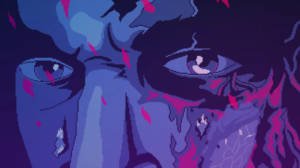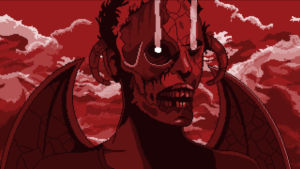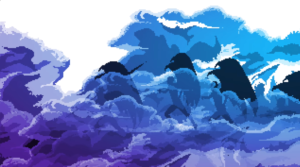Milton’s Paradise Lost has proven to be popular within the horror genre.1 The latest example of horror’s homage to Milton has come in the form of the video for the song “Arise” off the 2016 album Non Paradisi by GosT, the skull-masked, synthwave solo act. GosT’s label, Blood Music, is described as an organization “dedicated to anthropological and cultural preservation of extreme metal music,” yet “Arise” is very much reminiscent of a 1980s, John Carpenter-style, synthesized horror film soundtrack. Proudly donning its Miltonic influences on its sleeve, GosT’s Non Paradisi album is described as “a loose musical adaptation of John Milton’s epic poem Paradise Lost, concerning Lucifer’s fall from Heaven and ensuing ascent from the Lake of Fire.” The video for “Arise”—itself a reference to the call with which Milton’s Satan summons his fallen legions in Hell (“Awake, arise, or be for ever fall’n” [I.330])—charts this Satanic epic, with imagery commingling traditional illustrations of Paradise Lost and Halloween-style horror.
While the video for Delta Heavy’s “White Flag” had a smooth and cartoonish Super Nintendo look, the video for “Arise” has more of a gritty and violent Sega Genesis style, which works well for GosT’s 80s horror aesthetic. I’m not convinced that it works for the Miltonic-Romantic Lucifer, however. “Arise” highlights the ambivalence of horror’s adoption of Paradise Lost, as the genre’s homage to Milton’s masterpiece can have a negative impact on the epic poem’s unique vision of the Satanic. With the exception of the video’s original opening—the silhouettes of rebel angels in their retreat and Lucifer’s ejection from Heaven—most of the imagery is lifted straight from the artwork of Gustave Doré and John Martin (in some cases depicting moments preceding and following those captured by the artwork). Yet the majestic artwork of Doré and Martin does not mesh well with the Halloween imagery the “Arise” video is suffused with: an overabundance of skulls, skeletons, inverted crosses, and monsters.
Paradise Lost has some elements of the monstrous, such as the native denizens of Hell—“worse / Than Fables yet have feign’d, or fear conceiv’d, / Gorgons and Hydras, and Chimeras dire” (II.626–28)—and Sin and Death (II.648 ff.), but such monstrousness does not quite extend to the fallen angels. Of course, Milton does in the end bring Satan and his coconspirators horrifyingly low: when he returns to Hell after triumphing in Eden, Satan is transformed into “A monstrous Serpent on his Belly prone” (X.514) at the conclusion of his exultant speech, Satan’s supporters suffering the same ignominy, “all transform’d / Alike, to Serpents all as accessories / To his bold Riot…” (X.519–21). Satan’s judgment seems reminiscent of Dante’s Inferno insofar as his punishment in Hell correlates to his crime on Earth, Satan “punisht in the shape he sinn’d, / According to his doom” (X.516–17), but in truth Milton’s judgment is far less harsh than Dantean torment because it is a temporary punishment. Milton writes of his writhing fallen angels, “thir lost shape, permitted, they resum’d,” explaining to the reader that this ignominious metamorphosis is merely an “annual humbling certain number’d days, / To dash thir pride, and joy for Man seduc’t” (X.574, 576–77).
 The lost shape Paradise Lost’s fallen angels resume is rather dignified: Milton likens the Hell-doomed host to a lightning-scorched but nonetheless stately forest (I.612–15)—a far cry from the horribly deformed faces of the angels tossed into the fiery pit of Hell in the “Arise” video. No, Milton’s rebel angels, despite their diminished glory, bear “Godlike shapes and forms / Excelling human, Princely Dignities…” (I.358–59). None are as princely and godlike as Satan himself, who stands “above the rest / In shape and gesture proudly eminent / …like a Tow’r…” (I.589–91). As the heavenly Lucifer he was “Sun-bright” (VI.100), yet even as a ruined archangel in Hell he retains much of his “Original brightness” (I.592), Satan still likened to the Sun, but as obscured by a misty horizon or eclipsed by the moon (I.592–99)—“Dark’n’d so, yet shone / Above them all th’ Arch-Angel…” (I.599–600). The only trace of genuine deformity in Milton’s Satan is that “his face / Deep scars of Thunder had intrencht” (I.600–01), yet these battle scars only serve to make him seem more heroic, Satan’s thunder-scarred visage merely magnifying the impressiveness of his “Brows / Of dauntless courage, and considerate Pride” (I.602–3). To its credit, the “Arise” video depicts Satan’s facial scars, which have been entirely ignored by all artists of Milton’s poem. Unfortunately, the scars do not stop at a cracked porcelain face; by the end of “Arise,” Satan’s face has decayed to an almost skeletal state, and the horns protruding from his head are no less unflattering—no less unMiltonic.
The lost shape Paradise Lost’s fallen angels resume is rather dignified: Milton likens the Hell-doomed host to a lightning-scorched but nonetheless stately forest (I.612–15)—a far cry from the horribly deformed faces of the angels tossed into the fiery pit of Hell in the “Arise” video. No, Milton’s rebel angels, despite their diminished glory, bear “Godlike shapes and forms / Excelling human, Princely Dignities…” (I.358–59). None are as princely and godlike as Satan himself, who stands “above the rest / In shape and gesture proudly eminent / …like a Tow’r…” (I.589–91). As the heavenly Lucifer he was “Sun-bright” (VI.100), yet even as a ruined archangel in Hell he retains much of his “Original brightness” (I.592), Satan still likened to the Sun, but as obscured by a misty horizon or eclipsed by the moon (I.592–99)—“Dark’n’d so, yet shone / Above them all th’ Arch-Angel…” (I.599–600). The only trace of genuine deformity in Milton’s Satan is that “his face / Deep scars of Thunder had intrencht” (I.600–01), yet these battle scars only serve to make him seem more heroic, Satan’s thunder-scarred visage merely magnifying the impressiveness of his “Brows / Of dauntless courage, and considerate Pride” (I.602–3). To its credit, the “Arise” video depicts Satan’s facial scars, which have been entirely ignored by all artists of Milton’s poem. Unfortunately, the scars do not stop at a cracked porcelain face; by the end of “Arise,” Satan’s face has decayed to an almost skeletal state, and the horns protruding from his head are no less unflattering—no less unMiltonic.
 “Arise” delights in depicting such monstrous decay, and the triumph of the horror elements over the Miltonic-Romantic iconography is illustrated by the precedence the GosT character assumes in the video. Among the many Doré pieces the video employs is Doré’s towering Satan summoning Beëlzebub, but in this case Satan is recast as Beëlzebub, now looking up in awe at the towering figure of GosT, which makes for a jarring image. GosT’s eponymous frontman explained in an interview that the video’s variation on Paradise Lost was “casting GosT…as the right hand of Lucifer. In our version, GosT is instrumental in helping Lucifer rise from the lake of fire and triumphantly claim his new throne without the unjust hand of God controlling his every move.” Within the walls of “Pandemonium – the City of Satan,” however, it is GosT who is crowned the king of Hell and ascends the infernal throne, once again replacing Satan—this time, the Satan of Martin’s image. Satan’s seat is not only usurped but reduced in significance, Pandemonium reimagined as a gothic horror rock concert, GosT presiding over bestial demons. Meanwhile, Satan ascends to Eden (with raptured skeletons), and in the final shot of the demonic angel (“O how fall’n! how chang’d…” [PL, I.84]) overlooking Eden, it is quite clear that the Miltonic-Romantic Lucifer invoked at the start of the video has been consumed by the horror element.
“Arise” delights in depicting such monstrous decay, and the triumph of the horror elements over the Miltonic-Romantic iconography is illustrated by the precedence the GosT character assumes in the video. Among the many Doré pieces the video employs is Doré’s towering Satan summoning Beëlzebub, but in this case Satan is recast as Beëlzebub, now looking up in awe at the towering figure of GosT, which makes for a jarring image. GosT’s eponymous frontman explained in an interview that the video’s variation on Paradise Lost was “casting GosT…as the right hand of Lucifer. In our version, GosT is instrumental in helping Lucifer rise from the lake of fire and triumphantly claim his new throne without the unjust hand of God controlling his every move.” Within the walls of “Pandemonium – the City of Satan,” however, it is GosT who is crowned the king of Hell and ascends the infernal throne, once again replacing Satan—this time, the Satan of Martin’s image. Satan’s seat is not only usurped but reduced in significance, Pandemonium reimagined as a gothic horror rock concert, GosT presiding over bestial demons. Meanwhile, Satan ascends to Eden (with raptured skeletons), and in the final shot of the demonic angel (“O how fall’n! how chang’d…” [PL, I.84]) overlooking Eden, it is quite clear that the Miltonic-Romantic Lucifer invoked at the start of the video has been consumed by the horror element.
With “Arise,” Paradise Lost is exploited as a means of exalting the GosT brand—the symbolic significance of which is the GosT character’s coronation—but at the expense of the imagery of Milton’s poem, particularly as brought to life by Doré and Martin (and many others). GosT’s “Arise” was a nice attempt at playing with traditional Miltonic iconography, but the video highlights the double-edged sword of horror’s homage to Milton’s Paradise Lost.
Notes
1. See, for example, Laura Lunger Knoppers and Gregory M. Colón Semenza, eds. Milton in Popular Culture (New York: Palgrave Macmillan, [2006] 2007), “Part II: Milton in Horror Film,” pp. 83–124; Eric C. Brown, Milton on Film (Pittsburgh, PA: Duquesne University Press, 2015), Ch. 6, “ ‘All Hell Broke Loose’: The Horror Film,” pp. 283–324.↩
